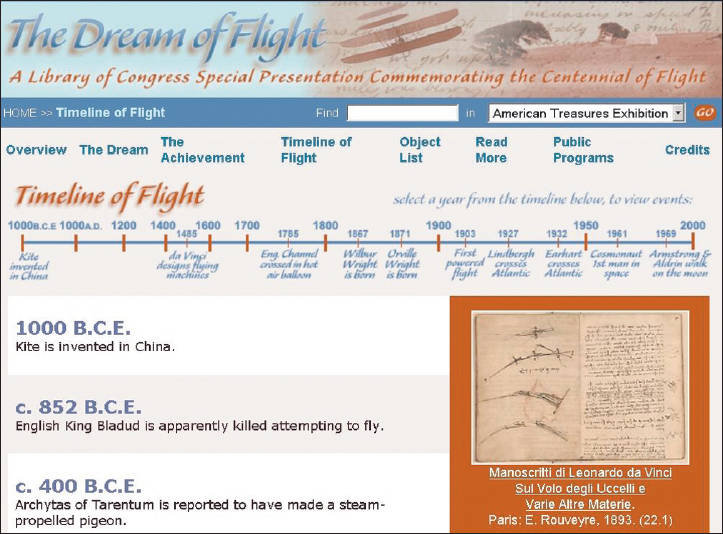Use calendar and clock time to create a sequence of events.
One of the simplest ways of constructing a clear time sequence is to place events on a timeline, with years or precise dates and times clearly marked. Look, for example, at the excerpted portion of a timeline in Figure 14.1, which presents a series of events in the history of flight. A timeline is not itself a narrative, but it shares with narrative two basic elements: Events are presented in chronological order, and each event is “time-stamped,” so that readers can clearly understand when events occurred in relation to one another.
Look now at a brief but fully developed narrative reconstructing the discovery of the bacterial cause of stomach ulcers. This narrative was written by Martin J. Blaser for Scientific American, a journal read primarily by nonspecialists interested in science. As you read, notice the same narrating strategies you saw in the timeline in Figure 14.1: sequencing events in chronological order and specifying when each event occurred:

Blaser cites specific years, months, days, and a holiday to convey the passage of time and indicate when each event occurred.
In 1979 J. Robin Warren, a pathologist at the Royal Perth Hospital in Australia, made a puzzling observation. As he examined tissue specimens from patients who had undergone stomach biopsies, he noticed that several samples had large numbers of curved and spiral-shaped bacteria. Ordinarily, stomach acid would destroy such organisms before they could settle in the stomach. But those Warren saw lay underneath the organ’s thick mucus layer—a lining that coats the stomach’s tissues and protects them from acid. Warren also noted that the bacteria were present only in tissue samples that were inflamed. Wondering whether the microbes might somehow be related to the irritation, he looked to the literature for clues and learned that German pathologists had witnessed similar organisms a century earlier. Because they could not grow the bacteria in culture, though, their findings had been ignored and then forgotten.
Warren, aided by an enthusiastic young trainee named Barry J. Marshall, also had difficulty growing the unknown bacteria in culture. He began his efforts in 1981. By April 1982 the two men had attempted to culture samples from 30-odd patients—all without success. Then the Easter holidays arrived. The hospital laboratory staff accidentally held some of the culture plates for five days instead of the usual two. On the fifth day, colonies emerged. The workers christened them Campylobacter pyloridis because they resembled pathogenic bacteria of the Campylobacter genus found in the intestinal tract. Early in 1983 Warren and Marshall published their first report, and within months scientists around the world had isolated the bacteria.
—MARTIN J. BLASER, “The Bacteria behind Ulcers”
In addition to calendar time (years, months, days), writers sometimes also refer to clock time (hours, minutes, seconds). Here is a brief narrative from an essay profiling the emergency room at Bellevue Hospital in New York City:
9:05 p.m. An ambulance backs into the receiving bay, its red and yellow lights flashing in and out of the lobby. A split second later, the glass doors burst open as a nurse and an attendant roll a mobile stretcher into the lobby. When the nurse screams, “Emergency!” the lobby explodes with activity as the way is cleared to the trauma room. Doctors appear from nowhere and transfer the bloodied body of a black man to the treatment table. Within seconds his clothes are stripped away.
––GEORGE SIMPSON, “The War Room at Bellevue”
The references to clock time establish the sequence and contribute to dramatic intensity.
EXERCISE 14.1
Skim Gabriel Thompson’s “A Gringo in the Lettuce Fields” in Chapter 3, and underline the references to calendar and clock time. How do you think these time markers function in the narrative? What do they tell you about the impression Thompson wants to create about that period of his life?